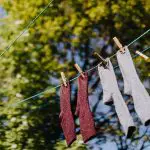You're not alone if you've ever wondered about gabardine. Did you know that this durable fabric was invented by Thomas Burberry in 1879 for his revolutionary raincoats?
Gabardine is a tightly woven, twill fabric known for its resilience and smooth finish. In this fabric guide, you'll explore the history, characteristics, weaving process, types, and fashion applications of gabardine.
You'll also learn about caring for gabardine and how it compares to other fabrics. Plus, we'll delve into sustainable gabardine options, equipping you with the knowledge to make informed choices about this versatile textile.
Whether you're a fashion enthusiast or a textile connoisseur, mastering gabardine will enhance your understanding of this timeless fabric.
Key Takeaways
- Gabardine is a tightly woven fabric with a smooth finish, known for its durability and resistance to wear and tear.
- It is woven using the twill weaving technique, which creates a distinctive diagonal pattern and enhances the fabric's strength and durability.
- Gabardine is versatile and can be used for various garment applications such as trousers, skirts, blazers, and dresses.
- It is available in different types such as cotton gabardine, wool gabardine, and synthetic blends, each offering specific benefits in terms of comfort, durability, and moisture-wicking properties.
The History of Gaberdine
Exploring the history of gaberdine, you'll discover its origins and evolution as a durable and water-resistant fabric. Early origins of gaberdine can be traced back to the Middle Ages, where it was widely used in England for outerwear. The fabric's name is believed to have originated from the Spanish word 'gabardina,' referencing a long, loose cloak worn by Spanish gentlemen. This sturdy, closely woven textile was valued for its ability to withstand the elements, making it an ideal choice for protective clothing in various climates.
Gaberdine also holds significant cultural importance. In addition to its practical uses, it became associated with academic regalia in the United Kingdom, where it's traditionally used for crafting the gowns and hoods worn by graduates during ceremonies. This further underscores the fabric's reputation for durability and sophistication.
Over time, gaberdine has evolved from its traditional uses into a versatile material utilized in fashion, workwear, and even military attire. Its enduring presence in diverse settings speaks to its lasting impact and relevance in the world of textiles.
Characteristics of Gaberdine
Gaberdine is a tightly woven fabric known for its durability and water resistance. Its fabric construction features diagonal ribbing, which gives it a strong, durable quality. Gaberdine is made using a twill weave, where the weft threads pass over one or more warp threads to create the distinctive diagonal pattern. This construction method not only contributes to the fabric's strength but also gives it a stylish and professional appearance.
| Gaberdine Properties | Description |
|---|---|
| Durability | Resistant to wear and tear |
| Water Resistance | Repels water effectively |
| Breathability | Allows air circulation |
| Wrinkle Resistance | Maintains a crisp look |
| Versatility | Suitable for various garments |
In terms of properties, gaberdine is highly sought after for its durability, as it is resistant to wear and tear. Additionally, its water resistance makes it an ideal choice for outerwear and other garments that need to withstand the elements. Despite its toughness, gaberdine remains breathable, ensuring comfort for the wearer. Moreover, its wrinkle resistance and versatility make it a practical and stylish option for a wide range of clothing items.
Gaberdine Weaving Process
So, how exactly is gaberdine woven?
Well, the answer lies in the twill weaving technique used to create this fabric. This weaving process results in a durable and strong fabric that's known for its versatility in various garment applications.
Twill Weaving Technique
When you examine the twill weaving technique used in gaberdine fabric, you'll notice the distinct diagonal pattern it creates. This weaving method enhances the fabric's strength and durability, making it a popular choice for garments that require resilience and longevity.
Here's what you need to know about the twill weaving technique:
- Diagonal Pattern: The twill weave creates a diagonal rib pattern that sets gaberdine apart from other woven fabrics.
- Durability: The diagonal structure of twill weaving improves the fabric's tensile strength, making it more resistant to wear and tear.
- Flexibility: Despite its strength, gaberdine remains flexible and comfortable to wear, making it ideal for everyday clothing.
- Distinct Appearance: The unique diagonal lines give gaberdine a sophisticated and textured appearance, adding visual interest to garments.
- Versatility: This weaving technique allows gaberdine to be used for a variety of garments, from trousers and suits to outerwear and uniforms.
Durable and Strong Fabric
To understand the durability and strength of gaberdine fabric, consider the weaving process that reinforces its resilience and longevity.
Gaberdine is constructed using a twill weave, which involves weaving the fabric in a diagonal pattern. This technique creates a strong, durable material that can withstand wear and tear, making it an excellent choice for long-lasting garment options.
The tight weave of gaberdine also contributes to its fabric strength, providing a sturdy foundation for clothing that's built to last.
When you invest in gaberdine garments, you can trust that they'll maintain their shape and integrity over time, ensuring that you get the most out of your wardrobe.
Whether you're looking for a reliable pair of trousers or a durable jacket, gaberdine fabric offers the durability and strength you need for enduring style.
Versatile Garment Applications
The gaberdine weaving process creates a fabric that's well-suited for a variety of garment applications, ranging from trousers to jackets. Gaberdine's unique weaving technique and sturdy composition make it an ideal choice for a wide range of garments.
Here's why gaberdine is a top pick for versatile garment applications:
- Trousers: Gaberdine's durability and wrinkle-resistant properties make it perfect for creating long-lasting and professional-looking trousers.
- Skirts: The fabric's versatility allows for comfortable and stylish skirts suitable for various occasions.
- Blazers: Gaberdine's structured drape and resistance to creasing make it an excellent choice for tailored blazers.
- Dresses: Its ability to hold its shape and resist wrinkles makes gaberdine an excellent fabric for creating elegant and durable dresses.
- Uniforms: Due to its durability and easy maintenance, gaberdine is often used in uniforms for various professions, ensuring longevity and a polished appearance.
Types of Gaberdine
Exploring the various types of gaberdine can help you understand the versatility and durability of this fabric. Modern variations of gaberdine include cotton, wool, and synthetic blends.
Cotton gaberdine is breathable and lightweight, making it suitable for warm-weather clothing like trousers, suits, and outerwear. Wool gaberdine, on the other hand, is known for its insulating properties, making it ideal for creating durable, warm coats and suits. Synthetic blends offer a combination of durability, wrinkle resistance, and moisture-wicking properties, making them suitable for various applications.
Traditional uses of gaberdine include trench coats, military uniforms, and workwear due to its wind-resistant and water-repellent qualities. Trench coats made from gaberdine are renowned for their classic style and functionality, providing protection from the elements while maintaining a polished appearance. Military uniforms often feature gaberdine due to its durability and ability to withstand harsh conditions. Additionally, gaberdine workwear is favored for its ruggedness and resilience in demanding environments.
Understanding the different types of gaberdine empowers you to select the most suitable fabric for your specific garment needs, whether for fashion, work, or outdoor activities.
Gaberdine in Fashion
Now, let's talk about how gabardine has made a lasting impact in the world of fashion. Its remarkable durability has made it a staple in many wardrobes, while its versatility allows it to be used in a variety of clothing styles.
Additionally, delving into the history of gabardine in fashion sheds light on its enduring popularity and timeless appeal.
Gaberdine's Durability in Fashion
Considering gaberdine's durability, choosing this fabric for your fashion pieces ensures long-lasting wear and timeless style. Gaberdine's durability in fashion is unmatched, making it a top choice for those seeking longevity and resilience in their wardrobe.
Here's why gaberdine stands out in terms of durability in fashion:
- Resilient Technology: Gaberdine's long-lasting and resilient fabric technology ensures that your clothing can withstand the test of time.
- Workwear Fashion: Whether you're in a corporate setting or have an active lifestyle, gaberdine's durability makes it ideal for workwear fashion.
- Outdoor Durability: From windy city streets to rugged outdoor adventures, gaberdine's durability is perfect for outdoor wear.
- Stain Resistance: Its ability to repel stains makes gaberdine a practical and durable choice for everyday wear.
- Minimal Maintenance: With minimal care requirements, gaberdine allows you to enjoy durable fashion without the fuss.
Gaberdine truly elevates your fashion game with its unbeatable durability.
Gaberdine's Versatility in Fashion
When incorporating gaberdine in fashion, you'll appreciate its remarkable versatility, allowing you to seamlessly transition from casual to formal wear with ease.
This fabric's versatile styling makes it a favorite among designers and fashion enthusiasts alike. Whether you're aiming for a sophisticated office look, a casual weekend outfit, or even a chic formal ensemble, gaberdine can effortlessly adapt to your styling needs.
Its ability to take on various colors and finishes also makes it a timeless choice that can easily align with current fashion trends.
Embracing gaberdine in your wardrobe means having the flexibility to create diverse looks while enjoying the fabric's durability and refined appearance.
Stay ahead in the fashion game by integrating this adaptable fabric into your style repertoire.
Gaberdine's History in Fashion
Explore gaberdine's rich history in fashion, encompassing its influential role in the evolution of clothing styles and trends. Gaberdine's influence and historical significance have left an indelible mark on the fashion world.
- Military Roots: Originally used for military uniforms, gaberdine's durability and water-resistance made it indispensable for soldiers.
- Classic Tailoring: In the early 20th century, gaberdine became popular in classic tailored garments, such as trench coats and suits, due to its ability to hold a sharp crease.
- Rise in Sportswear: Gaberdine's adoption in sportswear, particularly in golf attire, showcased its versatility and comfort, further cementing its place in fashion.
- Modern Interpretations: Designers continue to reinvent gaberdine, incorporating it into contemporary collections, proving its enduring appeal.
- Sustainable Innovation: With the focus on sustainability, gaberdine's resurgence aligns with eco-friendly initiatives, making it a fabric of choice for conscientious fashion brands.
Caring for Gaberdine
To maintain gaberdine fabric, follow the care instructions provided on the garment's label.
Typically, gaberdine is a durable and easy-to-care-for fabric. Most gaberdine garments can be machine washed in cold water on a gentle cycle. It's best to use a mild detergent and avoid bleach or fabric softeners.
After washing, hang the garment to air dry or lay it flat. Avoid wringing out the fabric, as this can cause wrinkles and damage the fibers. If ironing is necessary, use a low heat setting and place a cloth between the iron and the gaberdine fabric to prevent scorching.
Additionally, it's essential to store gaberdine garments properly. Hang them on padded or broad hangers to maintain their shape and prevent wrinkles. Avoid hanging gaberdine in direct sunlight or damp areas to prevent discoloration or mold growth.
Gaberdine Vs. Other Fabrics
Comparing gaberdine's durability and water resistance to other fabrics' characteristics can help you understand its unique qualities. When pitted against denim, gaberdine stands out due to its superior durability and wrinkle-resistance. In activewear, gaberdine offers better water resistance compared to most other fabrics, making it an ideal choice for outdoor activities. Here's a closer look at how gaberdine compares to other fabrics:
- Gaberdine vs. Denim: Gaberdine is known for its exceptional durability and wrinkle-resistance, making it a more practical choice than denim for long-lasting and low-maintenance garments.
- Gaberdine in Activewear: When it comes to activewear, gaberdine's superior water resistance sets it apart from other fabrics, ensuring that you stay dry and comfortable during outdoor activities.
- Gaberdine vs. Cotton: Unlike cotton, gaberdine offers better water resistance and is less prone to wrinkling, making it a more practical choice for various garments, especially in unpredictable weather conditions.
- Gaberdine vs. Polyester: While polyester is known for its water resistance, gaberdine's natural breathability and wrinkle-resistance make it a more comfortable and low-maintenance option for everyday wear.
- Gaberdine vs. Nylon: Compared to nylon, gaberdine offers a more refined and polished look, while still providing excellent water resistance and durability, making it a versatile choice for both casual and formal attire.
Sustainable Gaberdine Options
For sustainable gaberdine options, consider looking into brands that have adopted eco-friendly production practices. Sustainable fashion is a growing trend, and many clothing companies are embracing ethical production processes to reduce their environmental impact. When shopping for gaberdine, seek out brands that prioritize sustainability by using organic or recycled materials, minimizing water and energy consumption, and ensuring fair labor practices.
Several brands are leading the way in sustainable gaberdine production. They prioritize using organic cotton or recycled polyester for their gaberdine fabrics, reducing the use of harmful chemicals and decreasing their carbon footprint. These brands also often implement innovative dyeing and finishing techniques that minimize water usage and chemical waste. By choosing gaberdine from these eco-conscious brands, you can support ethical production practices and contribute to a more sustainable fashion industry.
In addition to the materials used, consider the overall sustainability practices of the brand. Look for certifications such as Global Organic Textile Standard (GOTS) or OEKO-TEX Standard 100, which ensure that the gaberdine has been produced in an environmentally and socially responsible manner. By making informed choices, you can enjoy the durability and style of gaberdine while supporting a more sustainable and ethical fashion industry.
Frequently Asked Questions
Where Can I Purchase Gaberdine Fabric?
You can purchase gabardine fabric from various fabric suppliers and online retailers. They offer a wide range of options and colors, making it convenient to find the perfect gabardine fabric for your project.
Can Gaberdine Be Dyed or Printed With Designs?
Yes, gaberdine can be dyed using various options such as immersion dyeing, direct application, or garment dyeing. It can also be printed with designs using techniques like screen printing, digital printing, or block printing.
What Are Some Common Uses for Gaberdine Fabric Besides Clothing?
Gaberdine is versatile for a range of uses beyond clothing. It's innovative for upholstery, accessories, and other applications. Its durability and smooth finish make it ideal for creating high-quality items in various industries.
Are There Any Special Considerations for Sewing With Gaberdine Fabric?
When sewing with gabardine fabric, consider its tight weave and high twist yarns. Use sharp needles and fine pins to prevent snags. Employ topstitching for a professional finish. For fabric care, machine wash and line dry to maintain its crisp appearance.
Is Gaberdine Fabric Suitable for Outdoor or Active Wear?
Gaberdine fabric is ideal for outdoor activities due to its durability and water-resistant properties. Its sturdy construction makes it suitable for active wear, providing comfort and protection during various outdoor pursuits.
- Tetron Fabric for Marine Applications: Durability and Use Cases - June 18, 2025
- Tetron Fabric for Outdoor Furniture: Weather Resistance and Care - June 18, 2025
- Tetron Fabric for Wall Coverings: Style and Application Tips - June 18, 2025







